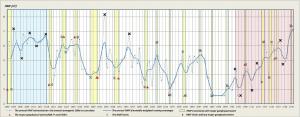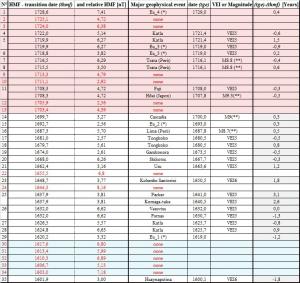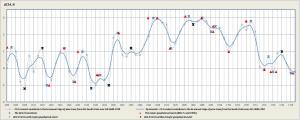EGU General Assembly 2016, held 17April – 22April, 2016 in Vienna, Austria
Session : The magnetic Earth: significant features and open questions
The magnetic field of the Earth is dynamic and is an important property of the planet. The study of its more significant spatial and temporal features are fundamental to understanding the past and the present state of the planet, and, importantly, its evolution into the future. There are several open questions that deserve more attention, for example, the present rapid decay of the field that could be a precursor to an excursion or a reversal, the geodynamo properties that are still hidden in the outer core, the existence in the present field of a large magnetic depression, the South Atlantic Anomaly, etcetera. This session is open to presentations concerning these questions and others related to the dynamics of the planet, the change of the Earth's magnetic field through its history and at the present time, together with possible consequences for life.
Michele,Casati; Valentino,Straser; Alessandro Feron
Abstract
In recent decades we are moving towards the hypothesis that electromagnetic (EM) processes inside the solar system (not yet fully understood from a physical point of view), may be linked with the energy released during major geophysical events (energy expressed in magnitude or Volcanic Explosivity Index). This research has focused on analysis of the temporal relationship between EM processes inside the solar system and major geophysical events around the crucial phase of the Maunder solar minima (1645-1715).
To carry out this study thirty-five limit values of the heliospheric magnetic field strength HMF (minimum and/or maximum) were compared, in terms of time, with twenty-one major geophysical events which occurred between 1600 and 1729. In the solar-terrestrial interaction, the concomitant conditions necessary for the amplification of the energy of the geophysical event, are two:
i. low solar activity during a long period (from decades to centuries), for example, the historical solar minima: Wolf, Sporer, Maunder, Dalton, etc. and
ii. fast and impulsive EM solar dynamo reorganizations in the short-term (one year or two years), are characteristic in the two periods of the solar cycle border, the incoming or outgoing of the solar minima or solar maximum.
The reconstructed intensity of the heliospheric magnetic field (HMF) was the main set of data used to carry out the present study. HMF evaluated by the annual cosmogenic 10Be ice core data from Dye 3 and North GRIP, in Greenland [McCracken;Beer,Sol.Phys.,2015 in press]. Analysis of the data shows that all the major geophysical events, with magnitude and volcanic explosivity index: 8.7 < M < 9.5 and VEI5 +, occurred in proximity of twenty-two limit values ( maximum or minimum ) of the reconstructed field strength HMF.
The possible proof of the link (time occurrence) of major geophysical events with unknown dynamics EM, in the deep solar minimum, is confirmed by taking into account the comparison of the dates of major geophysical events with:
i. the biannual variations of the content of carbon C14, in the tree rings of pine trees in the southern Urals,1600-1730 [Kocharov,1995] and
ii. the recent hypothesis of the solar minima that occurred in Maunder [Zolotova,2015].
Introduction
It is our opinion, that analysis of the preparatory phase leading to a major geophysical event (MGE), should not be limited to examining the EM signals (magnetic coupling between the Sun and the Earth) using up-to-date modern equipment (satellites and/or magnetic stations placed on the ground), but we should also study the MGEs occurred hundreds of years ago, through the examination of the reconstructed solar magnetic activity and terrestrial data.
Methodology
Initially we have processed the annual value of the reconstructed intensity of the heliospheric magnetic field B(PCR-1) to obtain the binomially weighted running averages (where the value for the Nth year is given by : X(N) = [ X(N-2) + 4* X(N-1) + 6* X(N) + 4* X(N+1) + X(N+2)]/16). Then we compared the two series (continuous and dashed lines, chart A & B) with :
i. thirteen large volcanic eruptions (VEI5+), Smithsonian Institute catalog (Global Volcanism Program),
ii. four large volcanic stratospheric eruptions [Gao,2008][Traufetter et.al,2004],
iii. four large historical earthquakes with magnitude: 8.7<M<9.5, USGS catalog [Yuzo Ishikawa,2012][Satake et al.,1996][Utsu, T.,2004].
Results
We observe :
i. in proximity to twenty-two (yellow sectors, chart A) of the thirty-five limit values (upper and lower, black and blue symbols “x”, chart A), of 130 annual values B(PCR-1) all MGE occurred,
ii. in proximity to thirteen of the thirty-five limit values B(PCR-1), an MGE did not occur (black symbol “x”, chart A),
iii. only two MGEs (Parker,04/01/1641; Komaga-take, 31/07/1640) occurred with a delay of over two years.
Chart “A” 1600-1729 - The thirty-five heliospheric transitions with MGEs (eighteen yellow bars or twenty-two limits of HMF) and without MGEs (thirteen limits of HMF).
The time occurrence of twenty-one MGEs compared with twenty-two limits values of the B(PCR-1) is (see table):
i. Δt = < 1 year (advance or delay) for fifteen of the twenty-one B(PCR-1),
ii. Δt = 1-2 years (advance or delay) for four of the twenty-one B(PCR-1),
iii. Δt = 2-3 years for one of the twenty-one B(PCR-1) in 1638, compared to large eruptions: Parker & Komogatake.
Table - From left to right, the thirty-five transitions HMF date (upper and lower limits): “thmf” and relative HMF intensity in nanoTesla, MGE date: “tge”, MGE category (VEI or magnitude) and time lag (number of years late or early) (tge-thmf). (*) = Major stratospheric volcanic eruptions (sulfate aerosol injection) [Gao,2008][Traufetter et.al,2004] (**) = Historical earthquakes [Yuzo Ishikawa, 2012][Satake et al., 1996][Utsu, T., 2004]
In addition the 1632_B(PCR-1) limit is concomitant with the volcanic eruption of Mount Vesuvius and it is about one year before the volcanic eruption of Furnas. The 1719_B(PCR-1) limit is a year and a half before the eruption of Katla and it is a year after the volcanic eruption Eu_3.
The trend of the reconstructed volcanic aerosols [Gao;Chaochao;Alan Robock; Caspar Ammann,2008][Traufetter et.al,2004], (chart B), shows:
i. four volcanic eruptions VEI5 + (Huaynaputina 1600, Parker & Komaga-take 1640 and Gamkonora 1673),
ii. three unknown large volcanic eruptions (Eu_n),
iii. four of six peaks (1619-1621; 1639-1641; 1673-1675 and from 1690 to 1965) are synchronized with low, and weak EM activity periods (dips of the blue line,chart B).
Chart “B” The four stratospheric volcanic eruptions (Huaynaputina 1600, Komaga-take 1640, Parker-1641 and Gamkonora 1673), the three unknown stratospheric volcanic eruptions (Eu_1(1619);Eu_2(1693) and Eu_3(1719)) and reconstructed HMF dips.
Discussion
Distant from Mm (Maunder minimum): Between 1603 and 1618 (blue sector, chart A), we have five limits of B(PCR-1) and no MGE. The EM activity is radically different compared to the core of the Mm. We note the absence of destabilization or irregularities in the series B(PCR-1) (short term) and the reconstructed values of HMF is consistently high, approximately between 6-7 nTesla. The Core of the Mm: In the middle period of solar minimum (approximately 1668-1700), six MGEs are synchronized, with seven limits of B(PCR-1) (Δt = <1 year). The Mm exit: Between 1700
and 1730 (red sector, chart A), fourteen limits of B(PCR-1) are connected to multiple EM oscillations. Six of the fourteen limits are not synchronized with MGEs. This period is the restoring of EM solar activity and it is the return to the 11-year solar cycle, with an higher EM.
Appendix - MGEs, the biannual variations of the content of carbon C14 and the solar minima suggested by Zolotova
The comparison between twenty-one MGEs with twenty-six biannual limits of variations of C14 (on sixty-six values of the constituent series), we find that :
i. in proximity to nineteen of the twenty-six limits twenty-one MGEs occurred ("x" blue symbols, chart C),
ii. in proximity to seven of the twenty-six values are MGEs did not occur ("x" blacks symbols, chart C).
The comparison of MGEs with solar minima suggested by Zolotova in his document "The minimum maunder is not as grand as it Seemed to be" (chart 9, page 10), we find that six MGEs coincide with six of the ten solar minimum (1619, 1630, 1640, 1650, 1680 and 1700).
Chart “C” The twenty-six limits of the C14 content variations in the bi-annual rings of pine-trees from the South Urals, with MGEs (nineteen limits) and without MGEs (seven limits).
Conclusions
Study of MGEs in Mm, corroborates the conclusions presented in our previous studies [Casati;Straser,2013][Casati;2014][Casati;Straser,2015].
The low solar minima are periods when a MGE is more likely. We hypothesize that unusual and unknown electrical phenomena in the solar minima are associated with great energy which is released during MGE.
Our direct appeal, to the scientific community, is therefore to study EM terrestrial processes in connection with EM processes inside the solar system. As shown by the latest documents of solar physics that identify the next thirty years as a period of low EM solar activity.[Ahluwalia,2013 [Goelzer;Smith;Schwadron;McCracken,2013][Livingston;Penn;Svalgaard,2012][Steinhilber ;Beer,2013][Shepherd,2015][Zachilas; Gkana,2015]
Acknowledgements
I am also thankful to Dr. Ken McCracken - Institute for Physical Science and Technology, University of Maryland, College Park, Maryland, USA - for his kind help in database management and plotting the annual Heliospheric Magnetic Field estimated from the annual cosmogenic 10Be ice core data from Dye 3 and North GRIP, in Greenland
References
Ahluwalia H.S., An empirical approach to predicting the key parameters for a sunspot number cycle University of New Mexico,Department of Physics & Astronomy,Albuquerque,NM 87131,USA An empirical approach to predicting the key parameters for a sunspot number cycle doi:10.1016/j.asr.2013.11.044
Casati M., Significant statistically relationship between the great volcanic eruptions and the count of sunspots from 1610 to the present, EGU General Assembly 2014, 27April - 02May, in Vienna, Austria id. EGU2014-1385-2
Casati M.,Straser V., Possible relationship between changes in IMF, M7+ earthquakes and VEI index, during the transition between the solar minimum cycle 23 and the rise of solar cycle 24, EGU General Assembly 2013, 7April -12 April, in Vienna, Austria id. EGU2013-1405
Casati M.,Straser V., Relationship between major geophysical events and the planetary magnetic Ap index, from 1844 to the present, EGU General Assembly 2015, 12April – 15April, 2015 in Vienna, Austria id. EGU2015-2501-2
Chesley, C., P. C. LaFemina, C. Puskas, and D. Kobayashi, 2012, The 1707 Mw8.7 Hoei earthquake triggered the largest historical eruption of Mt. Fuji, Geophys. Res. Lett., 39, L24309, doi:10.1029/2012GL053868
Gao, C., A. Robock, and C. Ammann, 2008, Volcanic forcing of climate over the past 1500 years: An improved ice core-based index for climate models, J. Geophys. Res., 113, D23111, doi:10.1029/2008JD010239
Goelzer, Smith, Schwadron, McCracken An analysis of heliospheric magnetic field flux based on sunspot number from 1749 to today and prediction for the coming solar minimum Journal of geophysical research: space physics, vol. 118, 7525–7531, doi:10.1002/2013ja019404, 2013
Traufetter, F. , Oerter, H. , Fischer, H. , Weller, R. and Miller, H., 2004, Spatio-temporal variability in volcanic sulphate deposition over the past 2 kyr in snow pits and firn cores from Amundsenisen, Dronning Maud Land, Antarctica , Journal of Glaciology, vol. 50, no. 168, pp. 137-146
Kocharov, G.E., Ostryakov, V.M., Peristykh, A.N. and Vasil’ev, V.A., 1995, “Radiocarbon Content Variations and Maunder Minimum of Solar Activity”, Solar Phys., 159, 381–391, doi:10.1007/BF00686539
Ishikawa Yuzo, 2012, Re-evaluation of Mw of the 1707 Hoei earthquake
Livingston, W., Penn, M. J.,Svalgaard, L. Decreasing Sunspot Magnetic Fields Explain Unique 10.7 cm Radio Flux The Astrophysical Journal Letters, Volume 757, Issue 1, article id. L8, 4 pp. (2012) doi:10.1088/2041-8205/757/1/L8
McCracken, K. G., and J. Beer. "The Annual Cosmic-Radiation Intensities 1391–2014; The Annual Heliospheric Magnetic Field Strengths 1391–1983, and Identification of Solar Cosmic-Ray Events in the Cosmogenic Record 1800– 1983." Solar Physics 290.10 (2015): 3051-3069
Satake, K., K. Shimazaki, Y. Tsuji and K. Ueda, Time and size of a giant earthquake in Cascadia inferred from Japanese tsunami records of January 1700, Nature, 379, 246-249, 1996, doi:10.1038/379246a0
Shepherd, S.J. et al. 2014 Prediction of Solar Activity from Solar Background Magnetic Field Variations in Cycles 21-23 ApJ 795 46 doi:10.1088/0004-637X/795/1/46
Steinhilber F., J. Beer, Prediction of solar activity for the next 500 years Journal of Geophysical Research: Space Physics Volume 118, Issue 5, pages 1861–1867, May 2013 doi:10.1002/jgra.50210
Zachilas, L., and A. Gkana. "On the Verge of a Grand Solar Minimum: A Second Maunder Minimum?." Solar Physics 290.5 (2015): 1457-1477 doi : 10.1007/s11207-015-0684-1
Zolotova N. V. , Ponyavin D. I., 2015 The Maunder Minimum is Not as Grand as it Seemed to be ApJ 800 42, doi:10.1088/0004-637X/800/1/42
Utsu Tokuji, 2006, Catalog of Damaging Earthquakes in the World (Through 2011),Tokyo University



